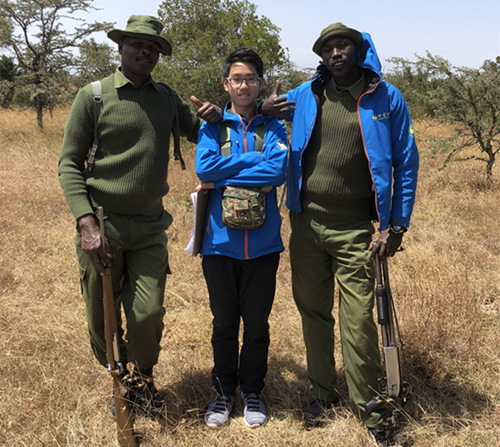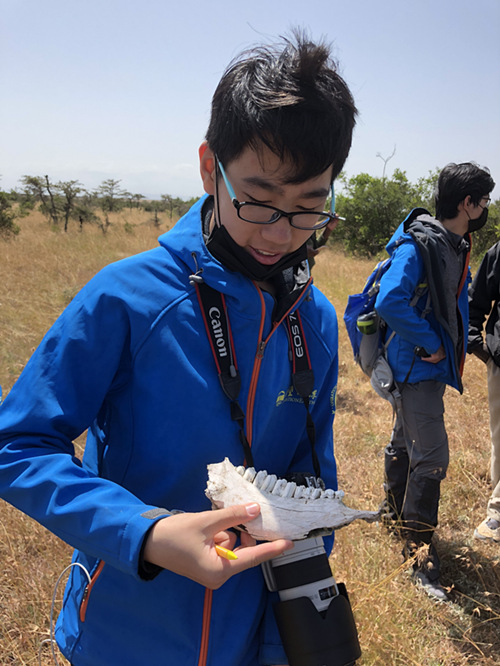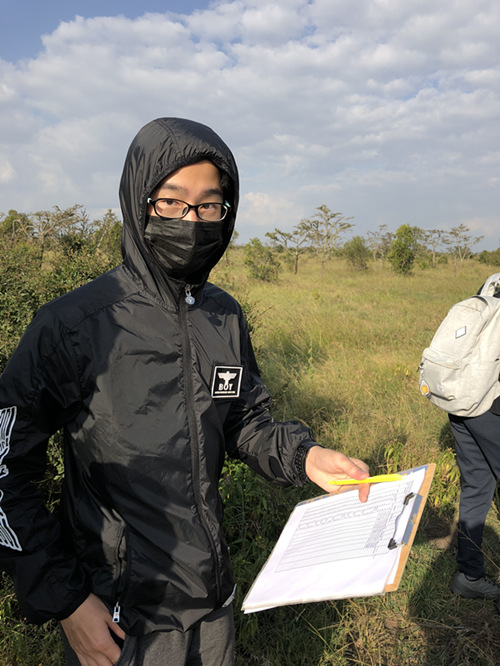By Albert Dai, a 15 years old student studying at Rectory School.

This is my first time taking part in a research team, which is about saving an endangered animal, although I was unfamiliar with black rhinos in Africa before. After a meaningful journey, I have learned so much about them, as well as other matters that would be beneficial to my future.
I have learned about their classifications, habits and food, habitats, recognition and differences between black and white rhinos and differences between Northern and Southern white rhinos while listening to experts who work at the Ol Pejeta Conservancy, such as Joseph, who is our research assistant.
I also got the chance to take a closer look at the last two female Northern white rhinos, which are protected along with another Southern white rhino who teaches them how to live in the wild since they had been living in the zoo. But it is a pity that they have some problems, making it hard for them to mate, and they could not see Sudan together, because the last Northern white rhino died last March.
We also did field research on rhinos, including measuring the height of the acacia, measuring the diameter of the main stem, checking whether the acacia was damaged, checking whether the damaged part is old or fresh, checking which part of the acacia is broken, measuring the height of the broken part of the acacia, checking the type of the broken part, checking the type of ants on the acacia by looking at their color and body shape, checking whether the acacia has any flower or seed, counting the number of spikes and galls on the branches and using the compass to locate the next acacia.

Buffalo teeth found on an eight-kilometer trek in the African savannah
I also saw what life is really like in Africa- living in a society with dust and trash that can be seen everywhere on the streets. Clean water is not easily accessible, finding a clean bathroom remains an extravagant hope, weather changes dramatically between the day and night, mosquitoes, flies and spiders are everywhere.
You must also contend with poor Internet connections. When first experiencing such problems it was uncomfortable and I had complained a lot, but after a few days, I had gotten more accustomed to life here.
I stopped complaining when learning that the locals were trying their best to make our lives better, renovating the toilets, adding some helminthic spray to the toilets and our tents, offering clean water so we could wash our hands and faces, cooking delicious meals and making our favorite drinks and juices, washing our clothes, making our beds, chatting with us and asking whether we needed anything else.
They had treated us better than themselves. Accordingly, I could pay more attention to the research. I used to think this would be a long and painful trip, but I found it to be a short and meaningful one, and do not wish to leave anymore. Before my arrival, I was saying we should protect the Earth, but now, I am actually doing it.

Monitoring acacia
I learned more about the relationship between nature and human beings. We play an important role over the extinctions of many animals, especially when I visited the Rhino Cemetery in Ol Pejeta and discovered how poaching had caused so many rhino deaths. People are causing the deterioration of the Earth’s environment by polluting the air, water, and vegetation.
We should atone for our "crimes" since every life deserves respect and this responsibility falls on our generation’s shoulders. We all live on one planet and we only have one Earth. Little efforts can make a big change, so I joined this research team to deliver a message that helps black rhinos in Africa at home and spread this information among my social groups, since "together, we can make it better."
I had gained better friendship during the trip. I was the youngest one and came from Shanghai while everyone else was from Beijing. My teammates gave me help while I was hurt by the spikes of the acacia, making me laugh when feeling depressed, answering my questions about research and chatting with me when I was lonely.
I recognized that I am so small and ignorant during the research period. I did not even know black rhinos are endangered at the beginning and there are only two female Northern White Rhino left. We worked hard, 4 hours daily, and we only did research on 200 acacias in 4 days, which is a little part of Ol Pejeta Conservancy.
What I am glad about is that what we had helped to increase black rhinos’ population in Africa. It is everyone’s responsibility to make the Earth a better place, but time is running out, so join us to save the black rhino!
(The opinions expressed here do not necessarily reflect the opinions of Panview or CCTV.com. )

Panview offers a new window of understanding the world as well as China through the views, opinions, and analysis of experts. We also welcome outside submissions, so feel free to send in your own editorials to "globalopinion@vip.cntv.cn" for consideration.
















